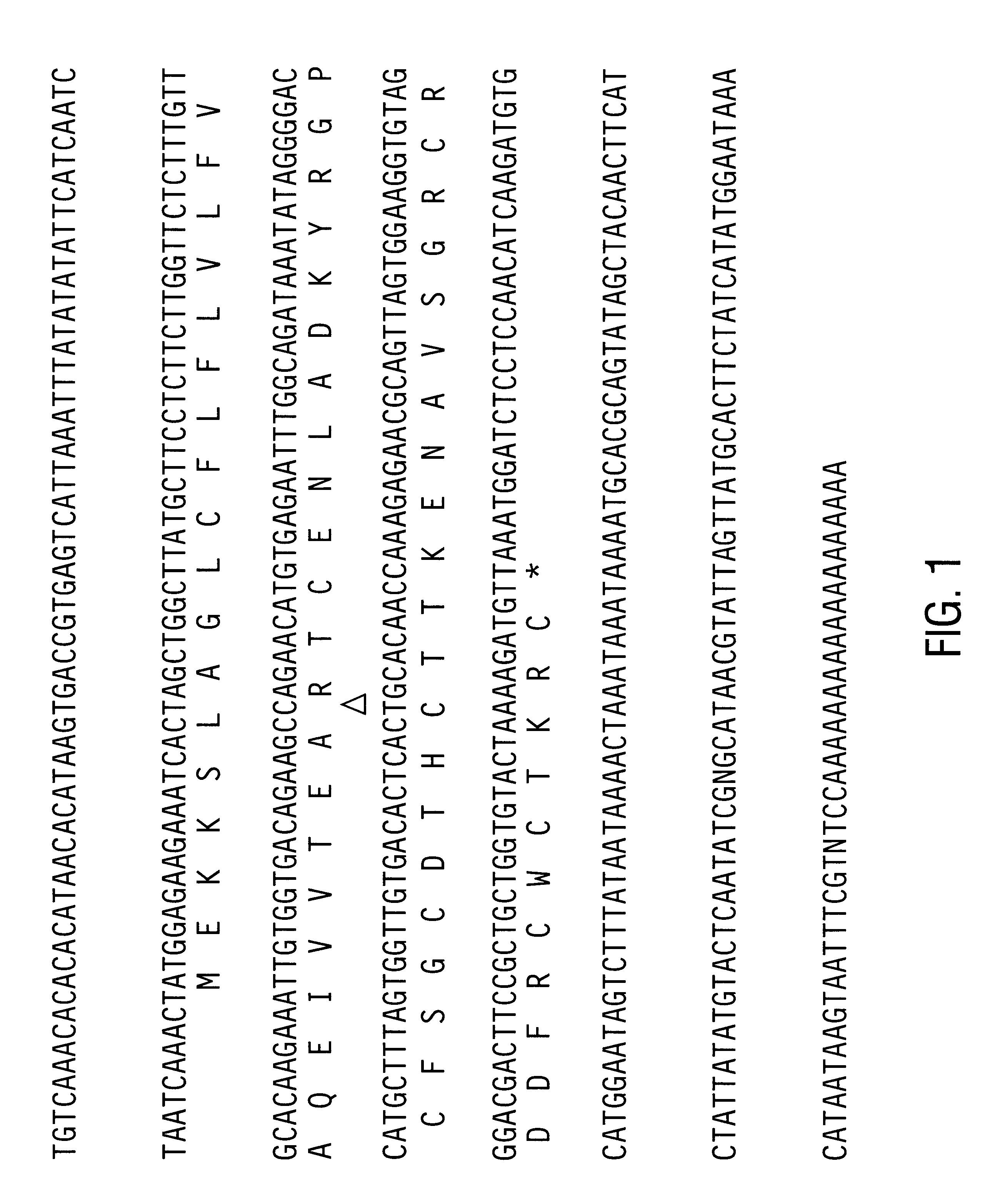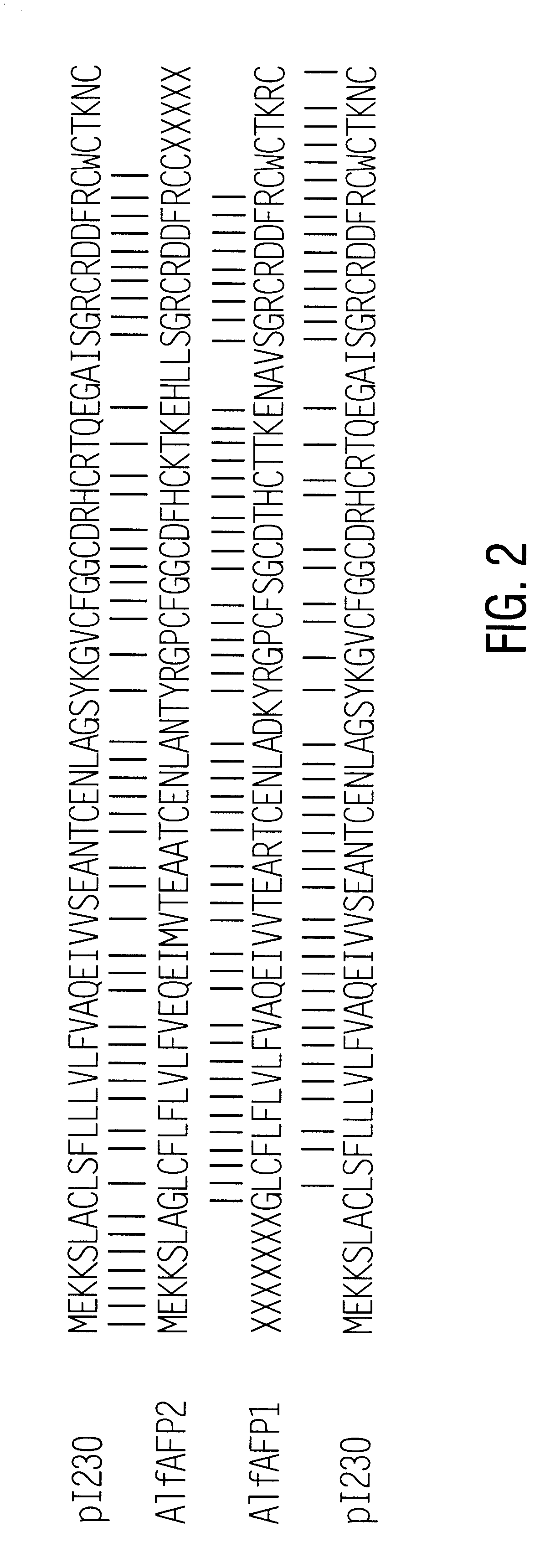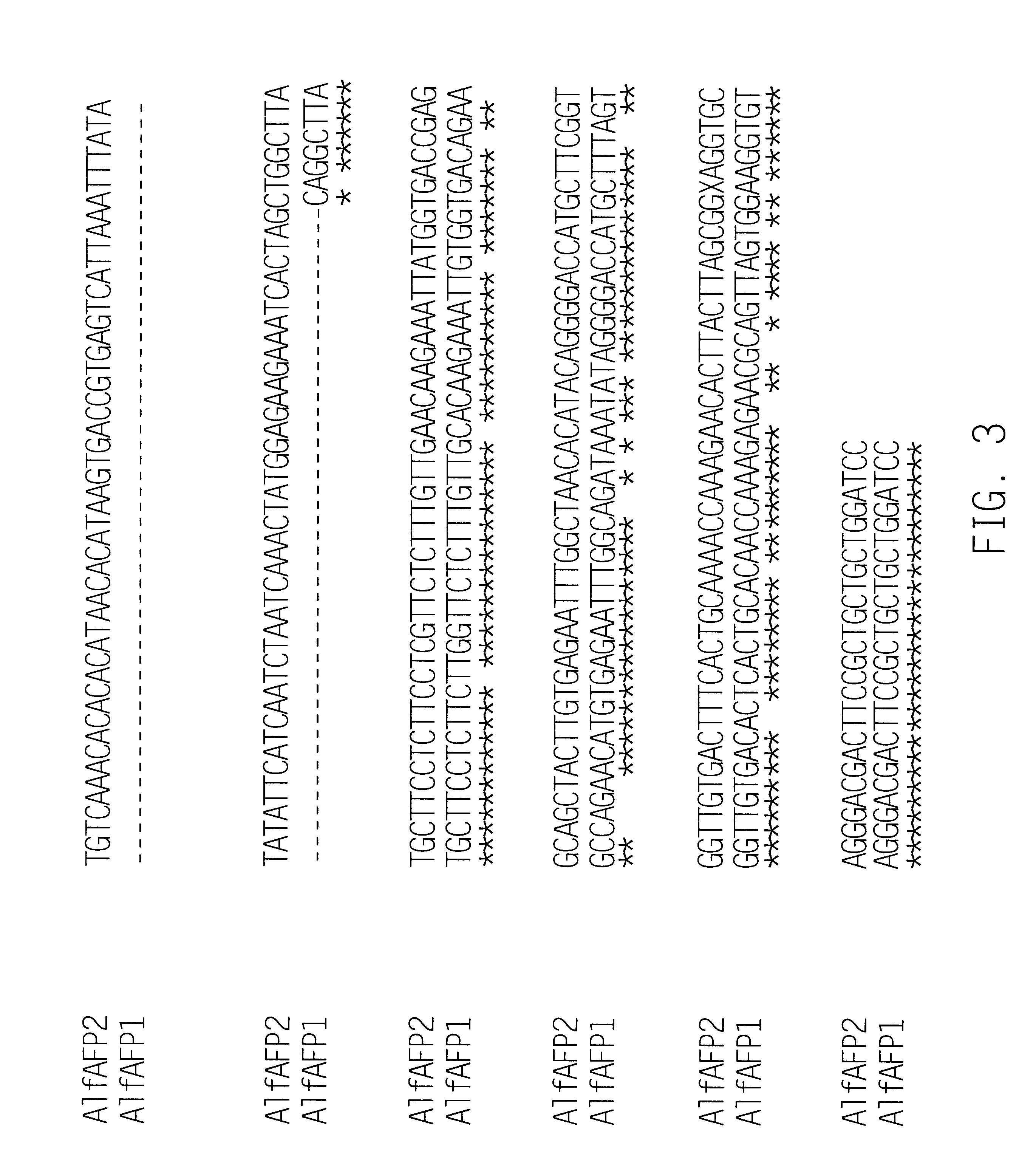Antifungal polypeptide from alfalfa and methods for controlling plant pathogenic fungi
a technology of antifungal polypeptides and alfalfa, which is applied in the field of antifungal polypeptides, can solve the problems of unreported protein products of this gene, ineffective fungicidal compounds, and inability to cure fungus infections
- Summary
- Abstract
- Description
- Claims
- Application Information
AI Technical Summary
Benefits of technology
Problems solved by technology
Method used
Image
Examples
example 1
5.1 Example 1
The molecular weight of AlfAFP1 was initially determined electrophoretically by the method of Laemmli (1970). The polypeptide was dissolved in denaturing sample buffer containing 450 mM Tris-HCl, pH 8.45, 12% glycerol, 4% SDS, 0.06% Coomassie Blue G, and 0.0025% Phenol Red (Novex, San Diego, Calif.), boiled for 10 min., and electrophoresed in a 16% Tricine gel (Novex, San Diego, Calif.) in electrophoresis buffer containing 100 mM Tris, 100 mM Tricine, and 1% SDS at 125V constant voltage for two hours. Silver staining (Integrated Separation Systems, Natick, Mass.) revealed a band having a molecular weight of approximately 6 kDa.
AlfAFP1 was mass-analyzed by positive ion electrospray mass spectrometry as described by Scoble et al., (1993). The observed molecular weight of the native polypeptide was approximately 5,186 daltons.
example 2
5.2 Example 2
Amino Acid Sequence of AlfAFP1
In order to determine the amino acid sequence of AlfAFP1, purified polypeptide (greater than 98% pure based on the mass spectrometric data) was denatured in 8 M urea containing 8 mM dithiothreitol. Cysteine residues were modified by S-carboxy-methylation as described by Stone et al., (1993). Reagents were removed by dialysis against distilled water using a membrane having a molecular weight cut-off of 1,000 kDa. Automated Edman degradation was carried out on an Applied Biosystems model 470A Protein Sequenator (Applied Biosystems, Norwalk, Conn.). The respective PTH-amino acid derivatives were identified by reversed phase analysis in an on-line fashion employing an Applied Biosystems Model 120 PTH Analyzer.
N-terminal sequencing of the polypeptide identified 43 amino acids as shown in SEQ ID NO:1 with ambiguous calls at positions 40 and 41. Information derived from mass spectrometric analysis of the polypeptide indicated that the polypeptide ...
example 3
5.3 Example 3
Bioefficacy of AlfAFP1
The antifungal activity of AlfAFP1 (SEQ ID NO:2) is expressed as the concentration in .mu.g / ml required to cause 50% inhibition of fungal hyphal growth (IC.sub.50). Percent fungal hyphal growth inhibition is defined as 100.times. the ratio of the average hyphae length in the test sample culture divided by the average hyphae length in the control culture in which buffer is added in place of the polypeptide sample.
The antifungal activity of AlfAFP1 was determined by measuring the inhibition of fungal hyphal length of a number of different fungi in the presence of this polypeptide under an inverted microscope. Fungal spores (2.times.10.sup.4 spores / ml) were allowed to germinate for 5 to 15 hours, depending on the fungus used in the test, in 50 .mu.l of double strength testing medium. The final single strength assay medium contained: K.sub.2 HPO.sub.4 (2.5 mM), MgSO.sub.4 (50 .mu.M), CaCl.sub.2 (50 .mu.M), FeSO.sub.4 (5 .mu.M), CoCl.sub.2 (0.1 .mu.M), ...
PUM
| Property | Measurement | Unit |
|---|---|---|
| temperatures | aaaaa | aaaaa |
| temperatures | aaaaa | aaaaa |
| temperatures | aaaaa | aaaaa |
Abstract
Description
Claims
Application Information
 Login to View More
Login to View More - R&D
- Intellectual Property
- Life Sciences
- Materials
- Tech Scout
- Unparalleled Data Quality
- Higher Quality Content
- 60% Fewer Hallucinations
Browse by: Latest US Patents, China's latest patents, Technical Efficacy Thesaurus, Application Domain, Technology Topic, Popular Technical Reports.
© 2025 PatSnap. All rights reserved.Legal|Privacy policy|Modern Slavery Act Transparency Statement|Sitemap|About US| Contact US: help@patsnap.com



